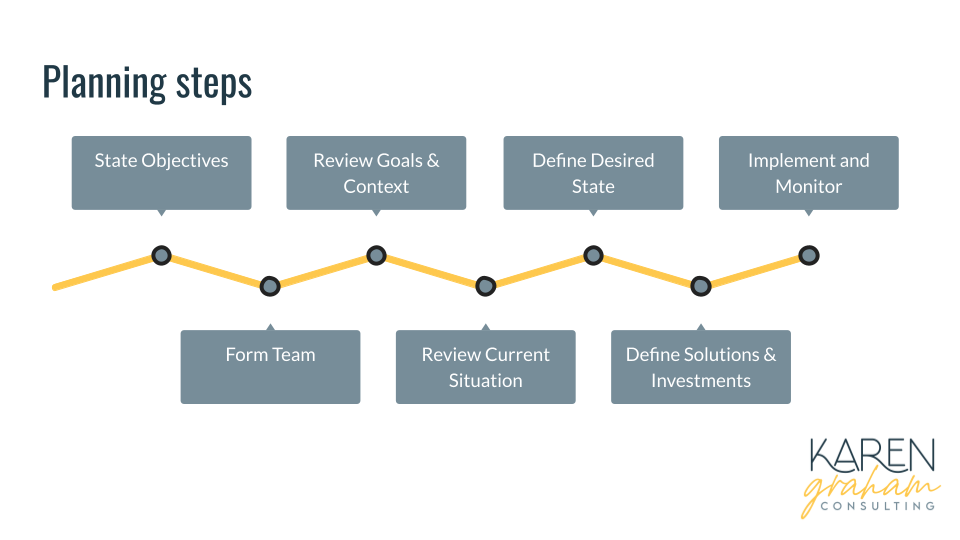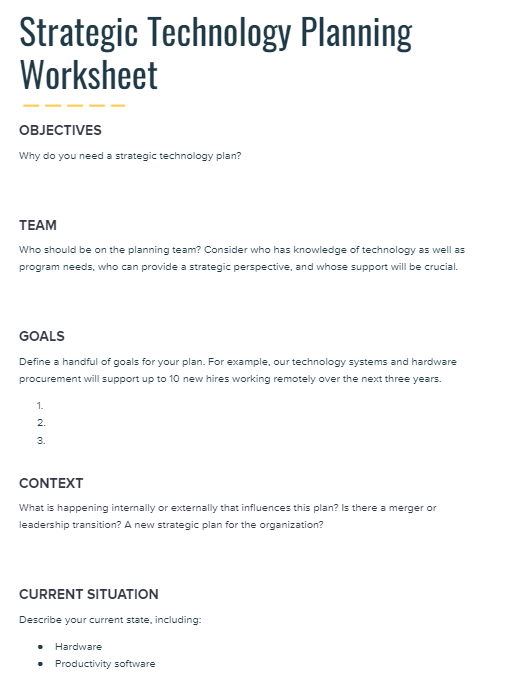
Why do tech planning?
To understand why technology planning matters, let’s start by imagining what it’s like to have no technology plan. An organization without a plan has trouble deciding how to allocate its resources. The organization likely wastes money because they aren’t taking advantage of sales and bulk purchases, and they’re using tools that aren’t the best fit for them–sometimes duplicate tools for the same purpose. Most importantly, they miss opportunities to use technology to improve the quality and reach of their programs.
Here are some advantages of having a technology plan:
Aligning technology with the organization’s goals, strategies, and values
Maximizing return on investment for your technology spending (streamlining cost and improving productivity)
Keeping client data secure and private
Improving impact of your programs
Convinced? Okay, here’s where to start.
Pre-work: assess digital maturity and get to a stable/secure/productive baseline
In other words, before you start remodeling the kitchen, fix the leaks in the roof.
To find the leaks, and gain an all-around understanding of what technology your organization is using and how that is working for you, consider doing an assessment. I can vouch for the Online Technology Assessment and the Digital Assessment Tool, because I was involved in developing both of them.
These, as well as NTEN’s Tech Accelerate and many others, will place your organization on a spectrum of digital maturity. I believe that’s helpful when you’re considering the level of effort and change management your technology plan will require, and what’s realistic for your organization.
An assessment will also help you identify basic fixes you need to address before moving on to more exciting technology projects. Some of the most important considerations include:
Reliable high-speed internet
Functional, current (less than five years old) computers for all staff
Tech support systems, including updates and patches, and someone to troubleshoot issues
Security practices such as password policies and cyber security awareness training
Data protection, including compliance with regulations like HIPAA
Tools and processes that support productivity and collaboration
What’s in a technology plan?
Your technology plan should include items you identified in the assessment which urgently need attention. But that’s not all it should include.
The best technology plans also incorporate:
Growth projects that have potential to transform your organization and multiply your impact, meeting not just today’s needs, but also tomorrow’s.
Guiding principles you can apply to decisions that lie over the horizon, positioning you to take advantage of technologies that haven’t even been invented yet.
Change management approaches that ensure user adoption and maximize the impact of technology initiatives.
Creating a technology plan
There are lots of blueprints for the technology planning process, and what I’ll share here is one that I developed with Tech Impact. You could use this for broad technology planning that encompasses all the ways technology is used in your organization. It also applies to a specific technology initiative.
 Chart depicting the planning steps, described below in text form
Chart depicting the planning steps, described below in text form
The first step is to state your objectives: be clear about what you are trying to accomplish.
Second, form a team and define roles. The composition of this team is important, so give it some thought.
Next, review strategic goals and context, including what else is going on in the organization or in the external environment that might affect this initiative.
Then, review your current situation, including tools and business processes.
Define your desired state, expressed as KPIs or measurable outcomes of the plan, such as increasing the number of volunteers by 20% over 12 months.
Then, after you have completed the previous five steps, it is finally time to start ideating over solutions. Here you will also want to find out what resources your idea requires, including money as well as time and expertise. Prioritize and sequence items based on resource requirements, impact, and interdependencies.
Lastly, implement and monitor the plan for success.
I created this worksheet to help you organize a simple planning process, and it’s free to download.
Common pitfalls to avoid
When technology planning goes haywire, it’s often for one of these three reasons:
Putting all your energy into technical aspects, and ignoring the humans. Technology is there to serve us, not the other way around, and it won’t fix everything. Learn and consider the needs and preferences of staff. Have a plan for change management that includes stakeholder impact, user adoption, and continuous improvement.
Being too rigid. Adapt your planning timeline and process to the ever-changing priorities and availability of people in your organization, and don’t get discouraged if things don’t go perfectly. Design flexible strategies that can respond to evolving needs and technologies.
Underestimating what’s required. Consider the full cost of ownership of technology solutions, including training, maintenance, and upgrades. If you think you know how much time the planning process will require…double it. Doing this right takes time and money, and if you’re willing to invest, you will see results.
Resources for further assistance and learning about tech planning
If you have never engaged in technology planning before, it can feel daunting, and fortunately there are lots of resources available to help you.
If you want to connect with peers, Nonprofits like NTEN (Nonprofit Technology Network) and TechSoup have membership forums and discussion boards where you can seek guidance and support on technology planning.
Many organizations look to consultants for help. Consider hiring a technology consultant (like me!) who specializes in nonprofits, and can provide personalized advice and facilitate your planning process.
If do-it-yourself is more your style, look for webinars, courses, and guides on reputable sites. A few examples are Tech Impact’s Tech Planning & Budgeting for Nonprofits course, offered on-demand and periodically live; and NTEN’s Nonprofit Tech Readiness cohort program.
Key points to remember
To sum up, a well-structured technology plan can guide your nonprofit organization toward making smart choices and using technology for better impact. It’s not just the plan itself, but also the process of creating it that builds a technology-positive culture and improves strategic alignment.
Start with identifying issues you need to address immediately in order to achieve stability and basic productivity. Then, look at ways technology could support growth, efficiency, better client experiences, and greater impact. Watch out for common pitfalls, and center the humans involved.
Anyone can do technology planning, and there are lots of resources available if you need a boost. Best wishes!
